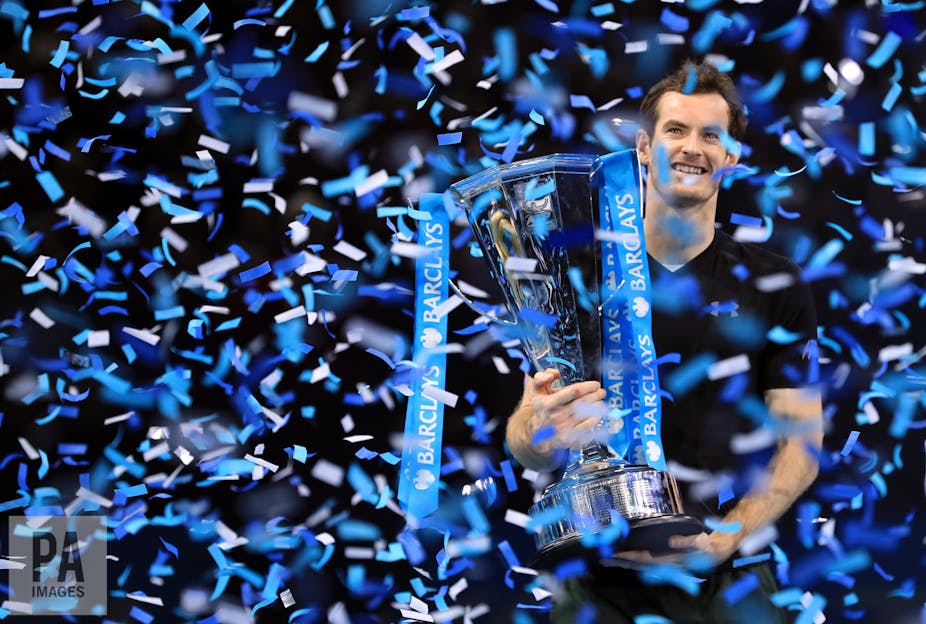Andy Murray has a had a pretty good year, both on and off the tennis court. Aside from becoming a father and the first three-time winner of the BBC Sports Personality of the Year award, he finishes 2016 as the ATP world number one, having retained his Olympic gold in Rio and a second Wimbledon title.
The Scot’s arrival at the very top of his game comes at the end of an 11-year trajectory that has seen a number of significant twists and turns. But one key ingredient behind such a tremendous sporting year is Murray’s history of relationships with coaches and sports science professionals. Over the years, his support staff have played different but vital roles in his development – technically, tactically, physically and mentally. And throughout his career, Murray has changed his coaching personnel in a continuing process of identifying and meeting specific needs as his world ranking climbed.
The idea of an optimally functioning athlete benefiting socially, emotionally, and motivationally from the relationship with their coach is a good explanation of Murray’s upwards career trajectory. After the well publicised tumultuous relationship and split with the highly respected Brad Gilbert in November 2007, many were surprised by the appointment of his good friend (but considered by some to be inexperienced) Miles Maclagan as coach. He stayed until 2010. However, this was the beginning of “Team Murray”. The player was surrounding himself with a team of experts – but importantly, experts whose company he enjoyed during the long months on tour.

The complex social bonds that lie at the heart of coach-athlete relationships are established from a young age. Murray’s tennis career blossomed under the guidance of his mother Judy, a tennis coach who instilled the fundamentals of his game and who has remained a crucial presence within his inner circle. His subsequent strong relationships in tennis have all developed from this initial powerful and positive parental relationship.
Athletes with an enduringly positive view of their relationship with their coach also perceive their support during negative episodes or disagreement, and are more likely to experience feelings of satisfaction. In Murray’s case, this negativity came at the expense of the complex and often misunderstood relationship with Judy. Branded a “mummy’s boy”, her proximity was once cited by former champion Boris Becker as the reason Murray would never win a Grand Slam. But after winning Grand Slams, Olympic golds, and the world number one position, his mother remains a motivational presence.
An elite athlete’s life is fraught with hardships and failures, and the importance of a solid relationship and mutual understanding with a coach is vital. Many top level players employ family members or close friends as coaches, and Murray, now working with former tennis-pro Jamie Delgado since February 2016, is no exception.
Murray’s previous appointment of a female coach in 2014, former women’s World No.1 Amelie Mauresmo was seen as novel because of the lack of women working in elite men’s tennis. But there was clearly much common ground in their tennis histories. Both had dealt with the burden of national expectation, and were perceived as not fulfilling their potential. The partnership did not last, ending in 2016, but during this time Murray bounced back from back surgery and regained his world number two ranking.
When conflicts do arise, athletes must be able to use them as motivation to achieve a higher standard. Unresolved interpersonal conflict with coaches might lead to performance slumps or lost motivation. Clashes with Gilbert were well-publicised, but Murray’s continued physical development is testament to Gilbert’s legacy – intensified training with the goal of adding bulk enabled him to increase his serve speed. Nine years after sacking Gilbert, Murray is 15kg heavier and recorded his fastest serve this year at 141mph (7mph greater than it was in 2007).
But of all various the coaches in Team Murray, it is Ivan Lendl who has been the focus of most discussion. The former World number one and winner of eight Grand Slams was Murray’s main coach from the end of 2011 until early 2014. He rejoined the team in 2016, and while the pair clearly get on well, that is not Lendl’s main role. He is there to share with Murray a single-minded pursuit of silverware. When he first sought Lendl’s input, Murray was the world’s fourth best player, and was yet to win a Grand Slam.
Lendl the ace
Lendl’s unwavering commitment to winning will not have been sugar coated, and there may have been difficulties between him and Murray. However these did not impact negatively on his performance – they spurred him on to win Grand Slams. Murray found a shared passion for winning titles, and it is no surprise that the rekindled 2016 relationship has been fruitful too, with another Wimbledon title, a second consecutive Olympic Gold, and the world number one crown.

It appears then, that unconditional positive regard – despite difficulties – between athlete and coach lays an unshakeable foundation on which to build performance. Trust and honesty are vital when difficulties arise, enabling conflict to be channelled positively. Clear focus on the evolving needs of the athlete (and person) are also powerful variables in the formula for success. And single-mindedness and conflict are only productive when the athlete is ready for them.
As Murray enjoys his place at the summit of men’s tennis, and the prospect of further dominance in 2017, his complex relationships with his coaches will no doubt continue, with further twists and turns yet to be played out – in domains well beyond the elements of performance witnessed in public.
These relationships are key to his current success - and should be studied in detail by future hopeful contenders for Sports Personality of the Year. Managed well, they have the potential to deliver yet more British sports stars to the top of their chosen fields.

